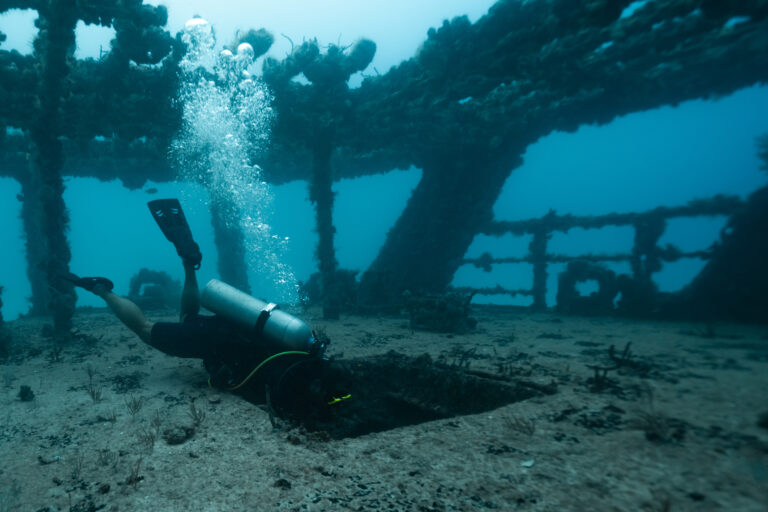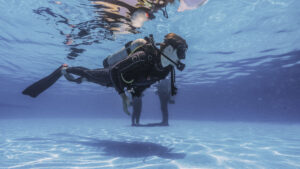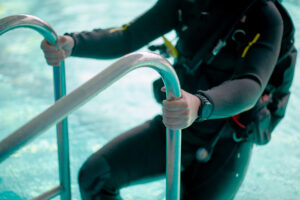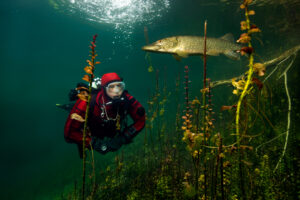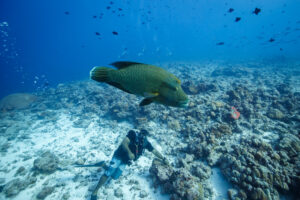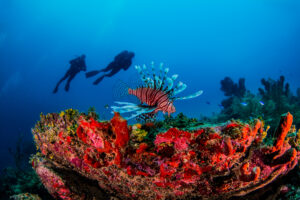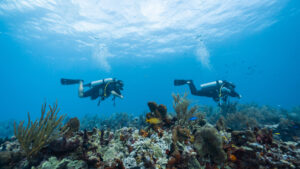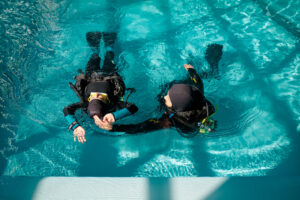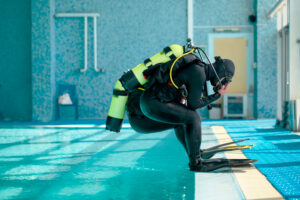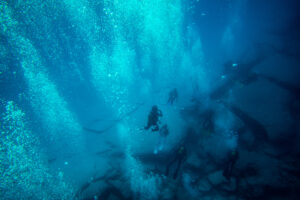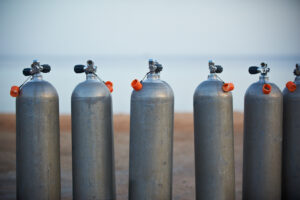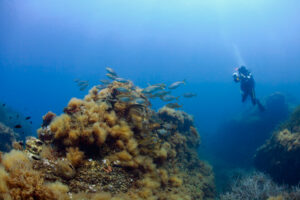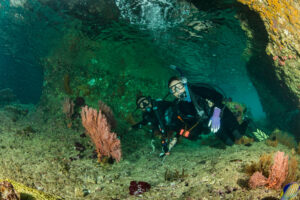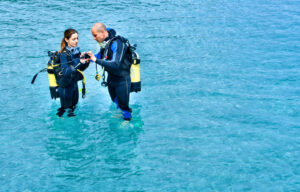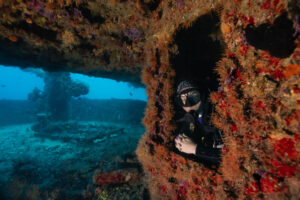What is Mixed Gas?
Mixed gas, in the context of scuba diving, refers to breathing gases other than air, which are used to extend bottom time, reduce decompression obligations, and manage the risks associated with deep diving. These mixtures can include combinations of oxygen, nitrogen, helium, and other inert gases, tailored to specific diving conditions and depths. By using mixed gases, divers can safely reach greater depths and explore environments that would otherwise be inaccessible due to the limitations of breathing air alone.
History and Development of Mixed Gas Diving
The history of mixed gas diving dates back to the early 20th century, when scientists and engineers began experimenting with different gas mixtures to overcome the challenges of deep-sea diving. In the 1920s, the U.S. Navy started to develop and test breathing gases that could reduce the risk of nitrogen narcosis and decompression sickness, common problems encountered with standard air diving at significant depths. These early experiments laid the groundwork for the use of helium-oxygen mixtures, known as heliox, which became a standard for deep diving operations.
During World War II, the need for improved diving techniques and technologies accelerated the development of mixed gas diving. The military’s interest in underwater demolition, salvage, and reconnaissance operations led to significant advancements in diving physiology and gas mixtures. Post-war, these innovations began to trickle down to commercial and recreational diving, allowing for safer and more efficient underwater work and exploration.
The 1970s and 1980s saw a surge in the popularity of technical diving, a form of diving that goes beyond the limits of recreational scuba diving. This period marked the introduction of trimix, a mixture of oxygen, nitrogen, and helium, which enabled divers to reach depths previously thought impossible. The evolution of mixed gas diving continued with advancements in dive computers, rebreathers, and decompression algorithms, making it more accessible and safer for a broader range of divers.
Types of Mixed Gases
Mixed gases used in diving include Nitrox, Trimix, and Heliox, each serving specific purposes based on the diving conditions and depths involved. Nitrox, also known as enriched air, is a mixture of oxygen and nitrogen with a higher oxygen content than atmospheric air. It is commonly used in recreational diving to reduce nitrogen uptake, allowing for longer bottom times and shorter surface intervals.
Trimix is a mixture of oxygen, nitrogen, and helium, used primarily in technical diving to manage the risks of nitrogen narcosis and oxygen toxicity at greater depths. By replacing some of the nitrogen and oxygen with helium, divers can safely descend to depths beyond the limits of Nitrox and air. Trimix mixtures can be adjusted to suit specific dive profiles, with varying percentages of each gas.
Heliox, a combination of helium and oxygen, is used in commercial and deep technical diving. The absence of nitrogen in Heliox eliminates the risk of nitrogen narcosis, making it suitable for extremely deep dives. However, due to its high cost and the complexities involved in its use, Heliox is typically reserved for specialized diving operations.
Other less common mixed gases include Hydreliox (hydrogen, helium, and oxygen) and Heliair (helium and air), which are used in specific scientific and commercial applications. Each gas mixture is selected based on its ability to provide a safe and breathable environment for divers at varying pressures and depths.
Physiological Effects of Mixed Gases
Diving with mixed gases impacts the body differently than breathing air, with each gas mixture presenting unique physiological effects. Nitrogen narcosis, often experienced when diving with air at depths beyond 30 meters (98.4 feet), is a condition where nitrogen under high pressure acts as an anesthetic, impairing cognitive and motor functions. By reducing the nitrogen content in the breathing mixture, as with Trimix or Heliox, divers can mitigate this effect and maintain clarity and coordination at greater depths.
Oxygen toxicity is another significant concern in mixed gas diving. At elevated partial pressures, oxygen can become toxic, affecting the central nervous system and pulmonary system. Symptoms of central nervous system oxygen toxicity include visual disturbances, nausea, twitching, and convulsions, which can be life-threatening underwater. Divers manage this risk by carefully controlling the oxygen content in their gas mixtures and adhering to established depth limits and exposure times.
Decompression sickness, also known as “the bends,” occurs when dissolved gases, primarily nitrogen, come out of solution and form bubbles in the body tissues and bloodstream during ascent. Mixed gas diving reduces the risk of decompression sickness by minimizing nitrogen absorption and allowing for more controlled decompression schedules. However, divers must still follow rigorous decompression protocols and use dive computers or tables to plan their ascents.
The use of helium in mixed gases also presents unique challenges. Helium is less dense than nitrogen, which reduces breathing resistance and work of breathing at depth. However, it conducts heat more efficiently than nitrogen, increasing the risk of hypothermia. Divers using helium-based mixtures must wear appropriate thermal protection to prevent body heat loss.
Equipment and Training Requirements
Mixed gas diving requires specialized equipment and training to ensure safety and efficiency. One of the critical pieces of equipment is the rebreather, a device that recycles exhaled gas by removing carbon dioxide and replenishing oxygen. Rebreathers are essential for mixed gas diving as they allow for longer dives with optimized gas mixtures, reducing the amount of gas needed to be carried.
Standard scuba regulators can also be used with mixed gases, but they must be specifically rated for the gas mixtures being used. Helium, for instance, requires regulators designed to handle its unique properties, such as lower density and higher thermal conductivity. Divers also need multiple gas cylinders with different mixtures, along with a means to switch between gases during the dive.
Training for mixed gas diving goes beyond basic scuba certification. Divers must complete advanced courses that cover the use of specific gas mixtures, the physiological effects of each gas, and the procedures for planning and executing dives. These courses include extensive theoretical knowledge as well as practical skills, such as gas analysis, equipment configuration, and emergency response.
Certification agencies, such as the Professional Association of Diving Instructors (PADI), Technical Diving International (TDI), and Global Underwater Explorers (GUE), offer specialized mixed gas courses. These programs ensure divers are well-prepared to handle the complexities of mixed gas diving and can safely explore deeper and more challenging underwater environments.
Safety Protocols and Risks
Safety is paramount in mixed gas diving, with stringent protocols and practices in place to manage the associated risks. One of the primary safety measures is thorough dive planning, which involves calculating gas consumption, decompression schedules, and contingency plans for emergencies. Divers use dive computers and software to create detailed dive plans that account for the specific gas mixtures and depths involved.
Pre-dive checks are critical to ensure all equipment is functioning correctly and that gas mixtures are accurately prepared and analyzed. Divers must verify the oxygen and helium content of their gas cylinders, check for leaks, and ensure that rebreathers are properly calibrated and scrubbers are fresh. Communication and teamwork are also vital, with divers frequently practicing drills for gas switching, equipment failure, and emergency ascent.
Managing the risks of nitrogen narcosis, oxygen toxicity, and decompression sickness requires adherence to established depth and time limits. Divers must monitor their depth and time closely, using dive computers to track their exposure to different gases and ensure they remain within safe limits. Regular practice of emergency procedures, such as controlled ascents and gas sharing, is essential to maintain readiness for unexpected situations.
Helium’s unique properties necessitate additional precautions, particularly regarding thermal protection and gas management. Divers must use insulated suits and gloves to prevent hypothermia and ensure they have sufficient gas reserves to complete their dives safely. Monitoring gas consumption and switching between gas mixtures at appropriate depths are crucial to maintaining safety.
Accurate record-keeping and post-dive analysis help divers learn from each dive and improve their techniques and safety practices. Logs of gas mixtures, dive profiles, and any issues encountered provide valuable data for future dives and contribute to ongoing improvements in mixed gas diving safety.
Applications of Mixed Gas Diving
Mixed gas diving has a wide range of applications across various fields, each benefiting from the extended depth and bottom time that these gases provide. In commercial diving, mixed gases are used for underwater construction, maintenance, and repair work on structures such as oil rigs, pipelines, and ship hulls. The ability to operate at greater depths and for longer periods increases the efficiency and effectiveness of these operations.
Scientific research is another area where mixed gas diving is invaluable. Marine biologists, archaeologists, and geologists use mixed gases to study deep-sea ecosystems, conduct underwater excavations, and collect geological samples. The extended bottom time and reduced risk of narcosis and decompression sickness allow scientists to conduct more thorough and detailed research in challenging underwater environments.
Recreational and technical diving enthusiasts also use mixed gases to explore deeper wrecks, caves, and other underwater sites that are beyond the reach of standard air diving. The use of Trimix and Heliox enables these divers to safely reach depths of over 100 meters (328 feet), discovering new frontiers and challenging themselves with more complex and rewarding dives.
Military and public safety diving operations also rely on mixed gases for missions that require deep or prolonged underwater activities. These operations include underwater search and recovery, explosive ordnance disposal, and covert reconnaissance. The ability to use tailored gas mixtures enhances the safety and effectiveness of these critical missions.
Key Takeaways
Mixed gas diving represents a significant advancement in scuba diving, enabling divers to safely reach greater depths and extend their bottom times. The use of gases such as Nitrox, Trimix, and Heliox reduces the risks of nitrogen narcosis, oxygen toxicity, and decompression sickness. However, it requires specialized equipment, rigorous training, and strict adherence to safety protocols. Mixed gas diving is essential in commercial, scientific, recreational, and military applications, opening up new possibilities for underwater exploration and work.

